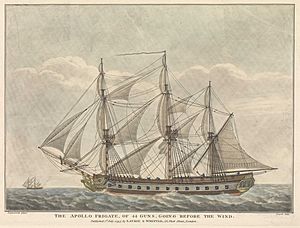HMS Apollo (1794) facts for kids

The Apollo frigate going before the wind
|
|
Quick facts for kids History |
|
|---|---|
| Name | HMS Apollo |
| Ordered | 28 March 1793 |
| Builder | Perry & Hankey, Blackwall |
| Laid down | March 1793 |
| Launched | 18 March 1794 |
| Completed | 23 September 1794 at Woolwich Dockyard |
| Commissioned | August 1794 |
| Fate | Wrecked on 7 January 1799 |
| General characteristics | |
| Class and type | 38-gun Artois-class fifth rate frigate |
| Tons burthen | 994 12⁄94 (bm) |
| Length |
|
| Beam | 39 ft 2 in (11.9 m) |
| Depth of hold | 13 ft 9 in (4.19 m) |
| Propulsion | Sails |
| Sail plan | Full-rigged ship |
| Complement | 270 |
| Armament |
|
HMS Apollo, named after the Greek god Apollo, was a powerful warship of the Royal Navy. She was a 38-gun frigate, a type of fast warship. Apollo served during the French Revolutionary Wars. Sadly, her time in service was short. After only four years, she was wrecked off the coast of the Netherlands.
Contents
Building a Warship: HMS Apollo's Construction
Building Apollo began on March 28, 1793. She was built at the yards of John Perry & Hanket in Blackwall. The ship was officially launched on March 18, 1794.
Apollo was then finished at Woolwich Dockyard by September 23, 1794. Her construction cost about £13,577. Getting her ready for sea brought the total cost to £20,779.
Apollo's Adventures at Sea
Apollo was launched in March 1794. She began her service in August under her first captain, John Manley. Her career started with a small problem.
Running Aground: A Tricky Start
In late 1794, Captain Manley accidentally ran Apollo aground. This happened on sandbanks near the mouth of the Wash. To free the ship, Manley ordered some of her supplies and guns to be thrown overboard.
This made the ship lighter, and she floated free. However, her rudder broke during the process. After some difficulty, she was sailed to Great Yarmouth for repairs.
Capturing French Ships
In June 1796, Apollo and Doris worked together. They captured a French warship called Légère. This ship had twenty-two 9-pounder guns and 168 men.
Légère had left Brest on June 4 with three other French frigates. She had captured six British ships during her journey. On June 23, Légère met Apollo and Doris. After a 10-hour chase, the British ships caught her. A few shots were fired, and then Légère surrendered. The Royal Navy took her into service as HMS Legere.
Later that year, in December, Apollo and Polyphemus were off the Irish coast. They captured another French ship. This was a 14-gun privateer schooner named Deux Amis. She had 80 men. The Royal Navy also took this ship into service.
Sharing Rewards
In 1798, Captain Peter Halkett became the commander of Apollo. Apollo shared rewards with other British ships. These ships included Cruizer, Lutine, and the hired cutter Rose. They shared money from capturing three ships on May 13: the Houismon, Welfart, and Ouldst Kendt.
The Final Voyage: Apollo's Wreck
In late 1798, an accident at sea forced Apollo back to port. This happened in Great Yarmouth. The accident also meant some of her crew could not continue serving.
An Unfortunate Accident
While the crew was raising the anchor, a part of the capstan broke. The capstan is a machine used to pull up heavy things like anchors. When the part broke, the anchor and chain suddenly dropped. This caused other parts of the capstan to spin quickly.
About thirty men were hurt when they were hit by these spinning parts. Captain Halkett ordered the ship to return to port right away. The injured men left Apollo and received medical care in Great Yarmouth. The ship then set sail again on January 5, without replacing the injured crew members.
Lost in the Fog
Captain Halkett's orders were to take Apollo to the coast of Holland. There, he was to look for Dutch ships to capture. On January 6, they saw a Dutch ship and Apollo began to chase it.
However, a very thick fog made the chase difficult. At 7 AM the next morning, Apollo ran aground. She hit the Haak Sandbank, which is near Texel. Halkett ordered the ship's supplies and guns to be thrown overboard. This was to make the ship lighter and help her float free. But even with these efforts, she remained stuck in the sand.
Abandoning Ship
In the late afternoon, a Prussian ship was seen. Apollo's crew called out to it. After some talks, the Prussian captain agreed to throw out most of his wine cargo. He would then take 250 of Apollo's crew back to England.
The remaining crew members got into Apollo's small boat, called a cutter. They planned to sail to port on their own. By 9 PM, all crew members had left the British ship. Apollo was then left to the sea. The Prussian ship reached Yarmouth on January 11. The cutter arrived three days later.
The Investigation
The Royal Navy held a special court hearing to find out why the ship was lost. Apollo's pilot, John Bruce, was found to have made big mistakes. He was removed from naval service right away.
No mistakes were found against Captain Halkett. He returned to the Navy with his previous rank. He was given command of a new 36-gun frigate, which was also named Apollo.
Apollo's Wreckage Today
HMS Apollo sank deep into the seabed after the accident. Over time, the ocean currents uncovered the wreckage. In 2020, the Cultural Heritage Agency of the Netherlands did research using sonar. Divers from the North Sea-Divers in Breezand in North Holland then brought some of the guns and equipment out of the water.

